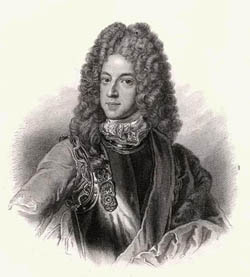 |
 |
 |
 |
 |
 |
 |
 |
 |
James III and VIII
Almost immediately after James's birth, a story was put about by the supporters of the Prince of Orange (James's brother-in-law), that the infant was not the son of James II and VII and of Mary Beatrice of Modena; the story suggested that the infant, born to another woman, had been smuggled into the queen's bedchamber in order to provide a Catholic heir to the throne. At the time, the queen was only 29 years old and had already borne ten children (five born live, and five stillborn), although none in the previous four years. At a meeting of the King's Privy Council on October 22, the story was shown to have absolutely no foundation. In November James was sent to Portsmouth, so that if necessary he could be taken across to France in order to protect him from the Prince of Orange. He was sent back to London, December 8, but the very next night he and the queen his mother travelled to Gravesend, and from there departed for France. James was brought up at the Palace of St. Germains-en-Laye, near Paris. He was named a Knight of the Most Noble Order of the Garter, April 19, 1692. He received his own household in June 1696, when James Drummond, Earl of Perth, was named his governor. At the death of his father King James II and VII, September 16, 1701, James succeeded to all of his British rights. He was henceforward recognised by the Jacobites as "King James III and VIII". He was immediately recognised as king by the courts of France, Spain, and Modena, as well as by the Holy See, but he failed to win the recognition of the Emperor. The young king's mother served as regent. On March 7, 1702, the Prince of Orange signed an Act of Attainder and Abjuration against James. The very next day the Prince of Orange died as the result of a fall from a horse. An unsuccessful attempt to restore James to his kingdom in Scotland was launched in 1708. His embarkation in a French fleet from Dunkirk was delayed by a bout of measles. The delay allowed the fleet of his half-sister Anne to be alerted. Although James and the French fleet reached the Firth of Forth, the French commander refused to permit James to land in Fife, and instead the fleet returned to Dunkirk. James continued to reside in France until 1713 when, in response to the Congress of Utrecht he moved to Bar-le-Duc, at that time in the independent Duchy of Lorraine. On December 22 (Old Style), January 2 (New Style), 1715 James landed in Scotland; he was, however, forced to withdraw on February 4 (Old Style), February 15 (New Style), 1716. After a brief time in France, he went to the city of Avignon, at that time still governed by the Pope. The following year James departed for Italy, where he first resided at Urbino. On May 9 (Old Style), May 19 (New Style), 1719, at Bologna, James was married by proxy to Clementina Sobieska, daughter of James Sobieski and of his wife, Princess Hedwig of Pfalz-Neuburg, and grand-daughter of King John III of Poland. The couple renewed their vows in person at the Episcopal Palace in Montefiascone, September 3, 1719. They had two sons:
After his marriage James took up residence in Rome at the Palazzo Muti (now Palazzo Balestra). He also maintained a country residence at Palazzo Savelli in Albano about 25 kilometres south of Rome. He was well received by the Italian nobility who were very happy to give him hospitality in their homes. James regularly travelled to Bologna and other towns where he was received with full royal honours. He maintained a court worthy of his rank thanks to pensions paid by the Holy See and by France, as well as thanks to many legacies which he received from cardinals and Italian nobles. On December 23, 1743, James appointed his elder son Charles, Prince Regent. In 1745 and 1746 the Prince Regent led a valiant by finally unsuccessful attempt to restore his father to his thrones. James died in the Palazzo Muti (now Palazzo Balestra) in Rome, January 1, 1766, when he was succeeded in all his British rights by his elder son Charles. His remains lie in the crypt of the Basilica of Saint Peter in the Vatican, where a monument designed by Antonio Canova was raised to his memory. Further reading:
This page is maintained by Noel S. McFerran (noel.mcferran@rogers.com) and was last updated January 1, 2011. © Noel S. McFerran 1997-2011. |
